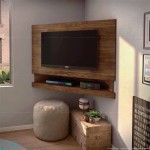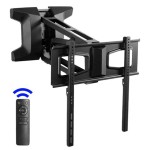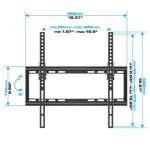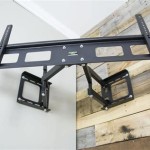Wall Mounted Surround Sound Systems: An In-Depth Guide
Wall mounted surround sound systems offer an elegant and space-saving solution for immersive audio experiences. These systems are designed to deliver high-quality sound while minimizing clutter and maximizing room aesthetics. The core benefit lies in their ability to create a realistic and engaging soundscape without requiring bulky floor-standing speakers or extensive cabling across the room.
This type of system typically consists of a combination of speakers designed to be mounted directly onto walls. This can include front left, front right, center channel, surround left, and surround right speakers, along with a subwoofer for low-frequency effects. The mounting brackets and hardware are typically included with the speaker systems, facilitating secure and visually appealing installation.
Choosing the right wall mounted surround sound system requires careful consideration of several factors, including room size, acoustic properties, budget, and personal preferences. The selection process involves evaluating speaker specifications, amplifier power, connectivity options, and overall system design. Proper installation is crucial to achieving optimal sound performance and maximizing the benefits of a wall mounted setup.
Advantages of Wall Mounted Surround Sound Systems
One of the primary advantages of wall mounted surround sound systems is their space-saving design. By eliminating the need for floor-standing speakers, these systems create more open space in the room. This is particularly beneficial for smaller living spaces where maximizing floor area is essential. The reduced footprint also contributes to a cleaner and more organized aesthetic, minimizing visual clutter and creating a more visually appealing environment.
Another major benefit of these systems is the improved aesthetics they offer. Wall mounted speakers can be seamlessly integrated into the room's decor, creating a clean and modern look. Many manufacturers offer speakers in a variety of finishes and styles, allowing homeowners to choose options that complement their existing interior design. Concealing speaker wires within the walls further enhances the aesthetic appeal, creating a truly seamless and unobtrusive audio experience.
Furthermore, wall mounting speakers can improve sound quality in certain room configurations. By positioning speakers at ear level, the listener receives a more direct and accurate soundstage. This can enhance the clarity and detail of the audio, resulting in a more immersive and enjoyable listening experience. Proper speaker placement also helps to minimize sound reflections and distortions, leading to a more balanced and natural sound reproduction.
Key Considerations When Selecting a Wall Mounted System
Before purchasing a wall mounted surround sound system, it is essential to assess the size and acoustic properties of the room. Larger rooms typically require more powerful speakers to fill the space with sound. The room's shape, materials, and furnishings can also affect sound quality, with hard surfaces tending to reflect sound and soft surfaces tending to absorb it. Conducting a simple acoustic analysis of the room can help determine the optimal speaker placement and power requirements for the system. This analysis should include noting the dimensions of the room, the type of flooring, wall coverings, and the presence of any large furniture items.
The amplifier power is another crucial factor to consider. The amplifier provides the necessary power to drive the speakers, and its power output should be matched to the speakers' power handling capabilities. Insufficient amplifier power can result in distorted sound and reduced volume, while excessive power can damage the speakers. It's important to choose an amplifier with sufficient headroom to accommodate dynamic peaks in the audio signal. A general rule of thumb is to select an amplifier with a power output that is at least equal to the speakers' RMS power handling rating.
Connectivity options are also important to consider, ensuring compatibility with existing audio and video equipment. Most surround sound systems support a variety of input and output connections, including HDMI, optical, coaxial, and RCA. HDMI connections are typically preferred for transmitting both audio and video signals, while optical and coaxial connections are commonly used for audio-only transmission. It's important to verify that the system has the necessary connections to support all desired devices, such as Blu-ray players, gaming consoles, and streaming devices.
Installation Best Practices for Wall Mounted Speakers
Proper installation is critical to achieving optimal sound performance from a wall mounted surround sound system. Before starting the installation process, it is essential to carefully plan the speaker placement, taking into account the room's acoustics and the listening position. The front left and front right speakers should be positioned symmetrically on either side of the listening area, typically at ear level. The center channel speaker should be placed directly above or below the television, ideally as close to the screen as possible. The surround left and surround right speakers should be positioned to the sides or slightly behind the listening position, creating a sense of envelopment.
Mounting the speakers securely is also essential to prevent them from falling and causing damage or injury. It is important to use appropriate mounting brackets and hardware that are specifically designed for wall mounted speakers. The brackets should be securely attached to the wall studs or using appropriate drywall anchors for added support. Ensure the brackets are rated to support the weight of the speakers. Using a stud finder to locate wall studs is crucial for a secure and stable mount.
Concealing the speaker wires within the walls can greatly enhance the aesthetic appeal of the system. This can be achieved by running the wires through the wall cavities and using wall plates to terminate the connections. It is important to follow local building codes and safety regulations when running wires within the walls. Using a cable management system can help keep the wires organized and prevent them from becoming tangled or damaged. Consider using in-wall rated speaker wire to ensure safety and compliance with building codes.
Furthermore, proper calibration of the system is crucial to achieving balanced and accurate sound reproduction. Many surround sound receivers include automatic calibration features that use a microphone to measure the room's acoustics and adjust the speaker levels accordingly. Fine-tuning the speaker levels and adjusting the equalizer settings can further optimize the sound quality. Room correction software, if available, can also help to compensate for acoustic imperfections in the room.
The subwoofer placement can greatly affect the bass response of the system. Experimenting with different subwoofer positions can help to find the optimal location for achieving a balanced and impactful bass sound. Placing the subwoofer in a corner can often increase the bass response, but it can also result in a boomy or uneven sound. Moving the subwoofer away from the wall can help to reduce these effects. A technique called the "subwoofer crawl" involves placing the subwoofer in the listening position and then crawling around the room to find the location where the bass sounds the best. This location is then where the subwoofer should be placed.
Finally, regular maintenance of the wall mounted surround sound system can help to ensure its longevity and optimal performance. Dusting the speakers regularly can prevent dust buildup from affecting the sound quality. Inspecting the speaker wires and connections periodically can help to identify and resolve any potential issues. Updating the receiver's firmware can also improve its performance and compatibility with new audio formats. Periodic cleaning of the speaker grilles is also recommended to maintain their aesthetic appearance.
In conclusion, wall mounted surround sound systems offer a compelling combination of space-saving design, improved aesthetics, and enhanced sound quality. By carefully considering the key factors outlined above and following the recommended installation practices, homeowners can create a truly immersive and enjoyable audio experience in their homes. The planning and execution of a wall-mounted system installation is a worthwhile investment for any audiophile or home theater enthusiast.

The Best In Wall Home Theater Speakers You Need To Know
How To Make Surround Sound Work In An Apartment

Home Theater Sound Systems Definitive Technology

Jamo A 804 Wall Mounted Surround Sound Speaker

Kef T301

On Wall Speaker Reviews Sound Vision

Hangman No Stud Surround Sound Mounting Kit Drill Bar Hanger

Bose Church Sound System With 2 S1 Pro All In One Pa Bluetooth Speakers And Adjustable

Speaker Wall Mount Dual Bracket Swm602

Fs 3118 3 10w 8Ω Home Theater Mini Wall Mount Satellite Speaker Ly International Electronics Co Ltd








